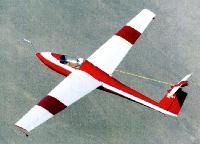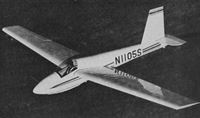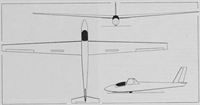Schweizer. Планеры
<...>
После войны "Schweizer" выпустила одноместный среднеплан SGS 1-23, выполнивший первый полет в 1948 году. Вскоре на нем были установлены мировые рекорды для планеров. Всего построили 93 планера нескольких подвариантов, производство прекращено в 1963 году.
<...>
В 1950-1960 годы было спроектировано несколько удачных планеров. Особенно длительной выдалась карьера одноместного среднеплана SGS 1-26, который серийно выпускался в 1954-1979 годах; всего построили 700 штук. В США SGS 1-26 стал самым массовым планером.
<...>
Показать полностьюShow all
M.Hardy. Gliders & Sailplanes of the world
Schweizer SGS 1-23
The Schweizer Aircraft Corporation of Elmira, New York, is the leading American designer and manufacturer of sailplanes, and has long specialised in all-metal types. The SGS 1-23 all-metal high performance single-seater was first flown at the 1948 US National Soaring Contest at Elmira, NY, and was based on the 1-21, which had won the previous year's US Nationals at Wichita Falls, Texas, flown by Dick Comey, General Manager of the Soaring Society of America. On 30 December 1950, a 1-23 flown by William Ivans set a new World height record of 42,100ft above sea level at Bishop, California, gaining 30,100ft from his aero-tow release height, and on 25 February 1961 a 1-23E flown by Paul Bikle set the current world height record of 46,266ft. The 1-23 has mid-set single-spar cantilever wings and is of truly all-metal construction with flush riveting, there being no fabric covering at all; 75ST alloy was used in the spar ends and fuselage centre-section, and the remainder of the structure was of 24ST Alclad. In its initial form the 1-23 had a wing span of 43ft 10in, and an aspect ratio of 12.88, and there were two sets of spoilers in the wing upper surfaces. The outside spoilers were double ones and could be locked in four positions, fully open as dive brakes or intermediately for the landing approach; the inner spoilers were single for glide control on the approach, and were coupled to the monowheel brake. There was a rubber-mounted skid forward of the non-retractable unsprung monowheel, and a small tail wheel. The SGS 1-23D like the 1-23B and 1-23C featured a wing increased in span to 50ft 0in, with an aspect ratio of 15.58, for improved performance, and production of this version started in July 1953; the wing tips were now square-cut instead of pointed as on the 1-23, and the fin and rudder were slightly larger. The D was later succeeded by the 1-23E in 1954, which had a wing span of 52ft 9 1/2 in and a thicker wing skin, and the 1-23F featured butt joints in the structure instead of lap joints. A larger fin and rudder with squared-off top distinguished the 1-23G, and one of these was developed into the experimental 1-29, which was basically a 1-23G fitted with a new constant-chord laminar flow wing, the first Schweizer design to be so fitted; this was used to flight test new design features as well as for competition flying. Final production versions, also with the larger vertical tail surfaces, were the 1-23H and 1-23H-15, the H having a span of 52ft 8in and limiting speed DFS-type air brakes which replaced the double spoilers of earlier versions, as well as detachable wing tips enabling it to be converted to a Standard Class 15m span, in which form it was known as the 1-23H-15. The pilot sits over the leading edge under a blown one-piece sideways-opening Perspex canopy, and there is room behind him for a radio, barograph and oxygen equipment. The 1-23H and H-15 hae a squared-off top to the fin and rudder.
Data: SGS 1-23H and 1-23H-15
Span: 52 ft 8 in (1-23H)
49 ft 2 1/2 in (1-23H-15)
Length: 20 ft 10 in
Wing area: 164.9 sq ft (1-23H)
159.4 sq ft (1-23H-15)
Aspect ratio: 16.9 (1-23H), 15.12 (1-23H-15)
Empty weight: 480 lb(1-23H), 474 lb(1-23H-15)
Max weight: 750 lb (both versions)
Max speed: 140 mph (both versions)
Min sinking speed: 2.05 ft/sec at 37 mph (1-23H)
2.15 ft/sec at 38 mph (1-23H-15)
Best glide ratio: 30.8:1 at 50 mph (1-23H)
29.2:1 at 50 mph (1-23H-15)
Schweizer SGS 1-26
This small medium performance single-seater, with a wing span of only 40ft 0in, was developed for one-design class activities, and is produced in kit form for the amateur constructor as well as complete at the Schweizer factory. It first flew in prototype form in January 1954 and following FAA Type Certification production began in November that year of 1-26s both complete and in kit form. To help the amateur constructor, all the complicated alignments, welding and assemblies requiring specialised tooling are undertaken by the manufacturer; included in the kit is a basic welded fuselage assembly, and parts such as a pre-formed aluminium nose cap and the moulded Plexiglas canopy. The 1-26 was reckoned to require from 300 to 600 man-hours for assembly, depending on the home-builder's skill and experience and, unlike the earlier SGS 1-23, it had fabric covering of the control surfaces, fuselage and tail unit. The prototype 1-26 had fabric-covered wings, whereas the 1-26B, which first flew in June 1956, had an all-metal skinned wing. The 1-26C is the kit version of the 1-26B, with a welded chrome-molybdenum steel tube fuselage with Ceconite fabric covering, and the 1-26D, which first flew in June 1968, featured a redesigned cockpit canopy, a metal nose section lowered to give improved visibility, and a new fin and rudder with squared-off top and straight trailing edge, replacing the curved top and rudder trailing edge of earlier versions. The SGS 1-26E first flew in March 1971 and is the current production version, with an all-metal semi-monocoque fuselage, and more than 700 1-26s of all variants had been produced by January 1980, of which about 200 were in kit form. An SGS 1-26E is to be a prototype for an electrically-powered light aircraft currently being studied by NASA's Dryden Flight Research Center and the Jet Propulsion Laboratory.
The 1-26E has cantilever all-metal mid-set wings of aluminium alloy, with metal skinning and fabric-covered ailerons, and balanced air brakes immediately aft of the spar. The cantilever tail unit is of aluminium alloy, with fabric covering on all versions. Landing gear consists of a non-retractable unsprung monowheel with a brake, with a nose skid mounted on solid rubber blocks just ahead of it; there is also a small solid rubber tailwheel, although the early versions had a tailskid, and there is a small wheel mounted under each wing tip. The pilot sits under a one-piece moulded Plexiglas canopy, and there is provision for radio to be carried.
Data: SGS 1-26E
Span: 40 ft 0 in
Length: 21 ft 6 1.2 in
Height: 7 ft 2 1/2 in
Wing area: 160.0 sqft
Aspect ratio: 10.0
Empty weight: 430 lb
Max weight: 700 lb
Max speed: 114 mph
Max aero-tow speed: 114 mph
Min sinking speed: 2.60 ft/sec
Best glide ratio: 23:1 at 53 mph
Schweizer SGS 1-34
This high performance Standard Class single-seater is intended to replace the popular SGS 1-23 series for club and syndicate use as well as for the private owner, and design work on it started in 1967; construction of the prototype began the following year, and it first flew in April 1969, the 1-34 receiving FAA Type Certification in September of that year. By January 1978 a total of 93 production 1-34s had been completed, the current production version being the SGS 1-34B, the 51st and subsequent aircraft being the 1-34A variant with a smoother wing upper surface through the use of bonded corrugations on the underside of the top skin. Of traditional Schweizer all-metal construction, the 1-34 has cantilever shoulder wings of aluminium alloy, with differential ailerons and double-flap type air brakes above and below each wing; no flaps are fitted. The fuselage is an aluminium alloy semi-monocoque structure, and the cantilever aluminium alloy tail unit has a swept back fin and rudder, and a fixed incidence tailplane with no trim tabs. Landing gear consists of a non-retractable monowheel (a retractable one can be fitted if desired) with a Cleveland brake; an unusual feature for a metal sailplane is the forward skid ahead of the monowheel, and there is also a tailwheel. The pilot sits under a large one-piece canopy and has an adjustable back rest.
Data: SGS 1-34B
Span: 49 ft 2 1/2 in
Length: 25 ft 9 in
Height: 7 ft 6 in
Wing area: 151.0 sqft
Aspect ratio: 16.04
Empty weight: 550 lb
Max weight: 800 Ib
Max speed: 135 mph (in smooth air)
Max aero-tow speed: 115 mph
Min sinking speed: 2.1 ft/sec at 46 mph
Best glide ratio: 34:1 at 52 mph
Schweizer SGS 1-35
The 1-35 is a high performance 15m Class singleseater which first flew in prototype form in April 1973, and completed its FAA certification programme in the spring of 1974. It is currently offered in two versions in addition to the standard 1-35, the SGS 1-35A Unrestricted 15m Class variant, and the SGS 1-35C, or Club-35, a simplified and cheaper version for club or syndicate ownership. The 1-35A has a retractable monowheel forward of the cg, with a hydraulic brake, a large tailwheel and no nose skid. Interconnected flaps and ailerons are standard, and the flaps can be lowered to 80° for use as air brakes; there is provision for up to 323lb of water ballast. The 1-35A is claimed to have the widest range of wing loadings in the FAI 15m Class, from 5.78 to 8.96lb per sq ft, enabling it to compete effectively in both weak and strong soaring conditions. Later production 1-35As have a more painted nose and improved wing root fairings. The 1-35C has a non-retractable unsprung Cleveland monowheel aft of the cg, with a hydraulic brake, and a nose skid plus a tailskid. There is no provision for water ballast, and the maximum wing loading is 6.59lb/sq ft. Low profile rivets are used on the 1-35C's rear fuselage, and its best glide ratio is 36:1 compared to 41:1 for the 1-34A. Altogether 96 1-35s of all versions had been built by January 1980. The type has cantilever shoulder wings with aluminium stressed skin and stringers, the ailerons and flaps being of aluminium torque cell construction; air brakes or spoilers are not fitted. The monocoque fuselage is entirely of aluminium, and incorporates an integral fin; the T-tail is likewise of aluminium with a fixed-incidence tailplane and fabric-covered elevator. The pilot sits in a semi-reclining position under a one-piece detachable canopy.
Data: SGS 1-35C
Span: 49 ft 2 1/2 in
Length: 19 ft 2 in
Height: 4 ft 5 in
Wing area: 103.8 sqft
Aspect ratio: 23.29
Empty weight: 425 lb
Max weight: 685 lb
Max speed: 139 mph
Max aero-tow speed: 139 mph
Best glide ratio: 36:1
Schweizer SGS 1-36
The SGS 1-36 Sprite single-seater is intended to be an all-round sailplane, which can be flown and soared by an inexperienced pilot shortly after his first solo, but is also easily capable of Diamond distance flights, and able to offer modern performance, handling and appearance whether as a personal, club or school aircraft. It will serve as a replacement for the veteran SGS 1-26 series, and a one-design competition class is planned. The prototype SGS 1-36 Sprite first flew on 2 August 1979, and the design is a cantilever mid-wing monoplane of traditional Schweizer all-metal construction. There are air brakes in both upper and lower wing surfaces, and also a cantilever T-tail with elevator. Landing gear consists of a fixed monowheel and tailwheel.
Span: 46 ft 2 in
Length: 20 ft 6 in
Height: 4 ft 7 3/4 in
Wing area: 140.7 sqft
Aspect ratio: 15.15
Empty weight: 450 lb
Max take-off weight: 710 lb
Max speed: 123 mph
Max aero-tow speed: 123 mph
Min sinking speed: 2.25 ft/sec at 46 mph
Best glide ratio: 31:1 at 57 mph
Показать полностьюShow all











